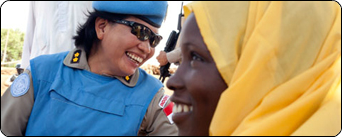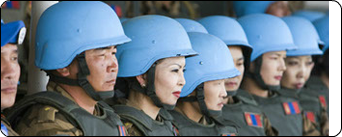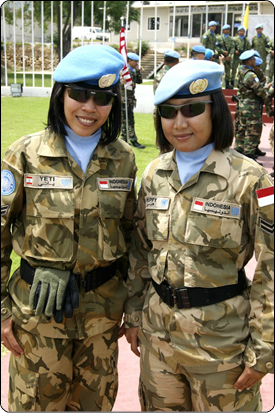Progress and challenges
Implementing the Women, Peace and Security framework.
The evolution of gender perspective in peacekeeping is theoretically extremely important, representing the base to determine real practical changes in gender promotion in peacekeeping missions. However, the implementation of gender promotion within peacekeeping operations, in terms of numbers, roles of women peacekeepers, and consideration of local women as active promoters for conflict resolution, is still very much constrained. Despite the several Security Council Resolutions that laid the theoretical foundations of a gender sensitive approach, this section presents the limitations to gender promotion in peacekeeping contexts. Sadly, this approach does not appear to be interiorized yet by the majority of peacekeeping actors, both military and civilian. It is also for this reason that gender training can be extremely important, as explained in this section.
Finally the section focuses on the importance of the role that military peacekeepers can play with regard to gender promotion. Former, present and future peacekeepers can find here basic tools and suggestions to adopt a gender perspective in their work in the field in a peacekeeping context.

The idea of gender promotion in peacekeeping is often directly associated with the presence of female peacekeepers in peace missions. In fact, recognizing that mixed operations made of women and men could have a positive impact in conflict resolutions represented the first step towards gender awareness within peacekeeping operations. At the beginning, the identified added value of women’s presence in peacekeeping missions was mainly correlated to the possible liaison that women peacekeepers (both military and civilian) could create with women of local population. For example women peacekeepers could be more easily approached by local women, and could also represent a model for empowerment.
This interpretation, certainly true in the majority of contexts, made it possible to understand that it is not only the number of women peacekeepers, but also the role they play, that are the critical elements to influence the course of a peacekeeping mission. This is mainly due to the fact that women and men can perceive conflict, and their solutions, in a different way. As such, a joint endeavour of both women and men peacekeepers, with equal positions and roles, contribute to the consideration of different elements in a conflict situation and multiply the ideas for its solution.
In the late nineties, with the development of the concept of Protection of Civilians (PoC), gender awareness started to focus also on a second subject: the women of the local population who found themselves in conditions of vulnerability due to the conflict. It was highlighted that these women may need specific protection measures that were different from those adopted for the protection of men.


Yet, it is with the adoption of the Security Council Resolution 1325 (2000), which acknowledged the relation between women, peace and security, that the concept of female participation in peacekeeping truly acquired a new perspective. To obtain the resolution of a conflict, the Security Council not only identified the need for a general gender perspective, but also recognized the role of local women as active players in society’s reconstruction. The 1325 Resolution is a cornerstone in the path towards gender awareness in peacekeeping contexts as it no longer perceived women as vulnerable subjects. Women need to be protected, but they also ought to have the possibility to participate to their own protection: as peacekeepers, within peace missions, and as promoters of peace. Seeing as women are the pillars of their communities’ social fabric, they can directly influence the course of a conflict and its resolution.
Despite this theoretical evolution and the adoption of several Security Council Resolutions, gender perspectives do not seem to be interiorised yet by peacekeeping actors, whether civilian, police, or military. In many peacekeeping contexts, gender and gender-based violence is not part of the civilia’s protection strategy. This implies that gender is not systematically used as a crucial element for resolution of conflicts. Usually, gender continues to be considered a factor of ‘vulnerability’, not an element to strengthen the resolution of conflicts. This results in a still limited application of the Resolutions, both in terms of presence of female peacekeepers, and of the ability to conceive peace strategies with a gender perspective.
More on progress and challenges of gender promotion in peacekeeping contexts
![[HOME]](images/blank.gif)







